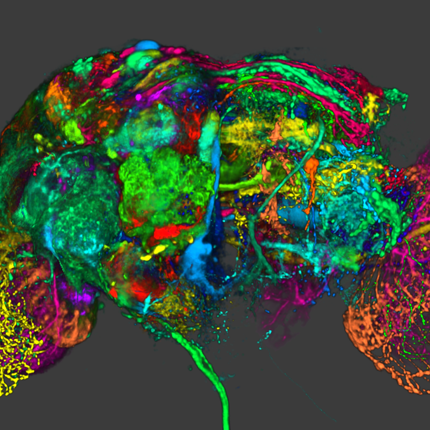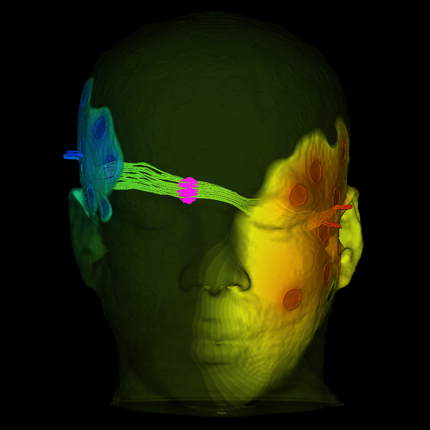Scientific Computing
Numerical simulation of real-world phenomena provides fertile ground for building interdisciplinary relationships. The SCI Institute has a long tradition of building these relationships in a win-win fashion – a win for the theoretical and algorithmic development of numerical modeling and simulation techniques and a win for the discipline-specific science of interest. High-order and adaptive methods, uncertainty quantification, complexity analysis, and parallelization are just some of the topics being investigated by SCI faculty. These areas of computing are being applied to a wide variety of engineering applications ranging from fluid mechanics and solid mechanics to bioelectricity.
Valerio Pascucci
Scientific Data Management
Chris Johnson
Problem Solving Environments
Ross Whitaker
GPUs
Chuck Hansen
GPUsFunded Research Projects:
Publications in Scientific Computing:
  Translational computer science at the scientific computing and imaging institute C. R. Johnson. In Journal of Computational Science, Vol. 52, pp. 101217. 2021. ISSN: 1877-7503 DOI: https://doi.org/10.1016/j.jocs.2020.101217 The Scientific Computing and Imaging (SCI) Institute at the University of Utah evolved from the SCI research group, started in 1994 by Professors Chris Johnson and Rob MacLeod. Over time, research centers funded by the National Institutes of Health, Department of Energy, and State of Utah significantly spurred growth, and SCI became a permanent interdisciplinary research institute in 2000. The SCI Institute is now home to more than 150 faculty, students, and staff. The history of the SCI Institute is underpinned by a culture of multidisciplinary, collaborative research, which led to its emergence as an internationally recognized leader in the development and use of visualization, scientific computing, and image analysis research to solve important problems in a broad range of domains in biomedicine, science, and engineering. A particular hallmark of SCI Institute research is the creation of open source software systems, including the SCIRun scientific problem-solving environment, Seg3D, ImageVis3D, Uintah, ViSUS, Nektar++, VisTrails, FluoRender, and FEBio. At this point, the SCI Institute has made more than 50 software packages broadly available to the scientific community under open-source licensing and supports them through web pages, documentation, and user groups. While the vast majority of academic research software is written and maintained by graduate students, the SCI Institute employs several professional software developers to help create, maintain, and document robust, tested, well-engineered open source software. The story of how and why we worked, and often struggled, to make professional software engineers an integral part of an academic research institute is crucial to the larger story of the SCI Institute’s success in translational computer science (TCS). |
  Adaptive Placement of Data Analysis Tasks For Staging Based In-Situ Processing Z. Wang, P. Subedi, M. Dorier, P.E. Davis, M. Parashar. In 2021 IEEE 28th International Conference on High Performance Computing, Data, and Analytics (HiPC), pp. 242-251. 2021. DOI: 10.1109/HiPC53243.2021.00038 In-situ processing addresses the gap between speeds of computing and I/O capabilities by processing data close to the data source, i.e., on the same system as the data source (e.g., a simulation). However, the effective implementation of in-situ processing workflows requires the optimization of several design parameters such as where on the system workflow data analysis/visualization (ana/vis) as placed and how execution as well as the interaction and data exchanges between ana/vis are coordinated. For example, in the case of hybrid in-situ processing, interacting ana/vis may be tightly or loosely coupled depending on their placement, and this can lead to very different performance and scalability. A key challenge is deciding the most appropriate ana/vis placement, which depends on dynamic applications, workflow, and system characteristics that might change at runtime. In this paper, we present a framework to support online adaptive data analysis placement during the execution of an in-situ workflow. Specifically, the paper presents a model and architecture, and explores several data analysis placement strategies. Evaluation results show that dynamically choosing appropriate data analysis placement strategies can balance the benefits and overhead of different data analysis placement patterns to reduce in-situ processing time. |
  Evaluating policy-driven adaptation on the Edge-to-Cloud Continuum D. Balouek-Thomert, I. Rodero, M. Parashar. In IEEE/ACM HPC for Urgent Decision Making (UrgentHPC), pp. 11-20. 2021. DOI: 10.1109/UrgentHPC54802.2021.00007 Developing data-driven applications requires developers and service providers to orchestrate data-to-discovery pipelines across distributed data sources and computing units. Realizing such pipelines poses two major challenges: programming analytics that reacts at runtime to unforeseen events, and adaptation of the resources and computing paths between the edge and the cloud. While these concerns are interdependent, they must be separated during the design process of the application and the deployment operations of the infrastructure. This work proposes a system stack for the adaptation of distributed analytics across the computing continuum. We implemented this software stack to evaluate its ability to continually balance the computation or data movement’s cost with the value of operations to the application objectives. Using a disaster response application, we observe that the system can select appropriate configurations while managing trade-offs between user-defined constraints, quality of results, and resource utilization. The evaluation shows that our model is able to adapt to variations in the data input size, bandwidth, and CPU capacities with minimal deadline violations (close to 10%). This constitutes encouraging results to benefit and facilitate the creation of ad-hoc computing paths for urgent science and time-critical decision-making. |
  An Adaptive Elasticity Policy For Staging Based In-Situ Processing Z. Wang, M. Dorier, P. Subedi, P..E Davis, M. Parashar. In IEEE Workshop on Workflows in Support of Large-Scale Science (WORKS), pp. 33-41. 2021. DOI: 10.1109/WORKS54523.2021.00010 In-situ processing alleviates the gap between computation and I/O capabilities by performing data analysis close to the data source. With simulation data varying in size and content during workflow execution, it becomes necessary for insitu processing to support resource elasticity, i.e., the ability to change resource configurations such as the number of computing nodes/processes during workflow execution. An elastic job may dynamically adjust resource configurations; it may use a few resources at the beginning and more resources towards the end of the job when interesting data appears. However, it is hard to predict a priori how many computing nodes/processes need to be added/removed during the workflow execution to adapt to changing workflow needs. How to efficiently guide elasticity operations, such as growing or shrinking the number of processes used for in-situ analysis during workflow execution, is an open-ended research question. In this paper, we present an adaptive elasticity policy that adopts workflow runtime information collected online to predict how to trigger the addition and removal of processes in order to minimize in-situ processing overheads. We integrate the presented elasticity policy into a staging-based elastic workflow and evaluate its efficiency in multiple elasticity scenarios. The results indicate that an adaptive elasticity policy can save overhead in finding a proper resource configuration, when compared with a static policy that uses a fixed number of processes for each rescaling operation. Finally, we discuss multiple existing research opportunities of elastic insitu processing from different aspects. |
  Material point method: Overview and challenges ahead (with videos) W. T. Sołowski, M. Berzins, W. Coombs, J. Guilkey, M. Möller, Q. A. Tran, T. Adibaskoro, S. Seyedan, R. Tielen, K. Soga. In Advances in Applied Mechanics, 1, Vol. 14, Ch. 2, Elsevier, pp. 113-204. 2021. ISBN: 978-0-323-88519-5 The paper gives an overview of Material Point Method and shows its evolution over the last 25 years. The Material Point Method developments followed a logical order. The article aims at identifying this order and show not only the current state of the art, but explain the drivers behind the developments and identify what is currently still missing.The paper explores modern implementations of both explicit and implicit Material Point Method. It concentrates mainly on uses of the method in engineering, but also gives a short overview of Material Point Method application in computer graphics and animation. Furthermore, the article gives overview of errors in the material point method algorithms, as well as identify gaps in knowledge, filling which would hopefully lead to a much more efficient and accurate Material Point Method. The paper also briefly discusses algorithms related to contact and boundaries, coupling the Material Point Method with other numerical methods and modeling of fractures. It also gives an overview of modeling of multi-phase continua with Material Point Method. The paper closes with numerical examples, aiming at showing the capabilities of Material Point Method in advanced simulations. Those include landslide modeling, multiphysics simulation of shaped charge explosion and simulations of granular material flow out of a silo undergoing changes from continuous to discontinuous and back to continuous behavior.The paper uniquely illustrates many of the developments not only with figures but also with videos, giving the whole extend of simulation instead of just a timestamped image |
  PrefixRL: Optimization of Parallel Prefix Circuits using Deep Reinforcement Learning R. Roy, J. Raiman, N. Kant, I. Elkin, R. Kirby, M. Siu, S. Oberman, S. Godil, B. Catanzaro. In 2021 58th ACM/IEEE Design Automation Conference (DAC), IEEE, pp. 853-858. 2021. DOI: 10.1109/DAC18074.2021.9586094 In this work, we present a reinforcement learning (RL) based approach to designing parallel prefix circuits such as adders or priority encoders that are fundamental to high-performance digital design. Unlike prior methods, our approach designs solutions tabula rasa purely through learning with synthesis in the loop. We design a grid-based state-action representation and an RL environment for constructing legal prefix circuits. Deep Convolutional RL agents trained on this environment produce prefix adder circuits that Pareto-dominate existing baselines with up to 16.0% and 30.2% lower area for the same delay in the 32b and 64b settings respectively. We observe that agents trained with open-source synthesis tools and cell library can design adder circuits that achieve lower area and delay than commercial tool adders in an industrial cell library. |
 RISE: Reducing I/O Contention in Staging-based Extreme-Scale In-situ Workflows, P. Subedi, P.E .Davis, M. Parashar. In 2021 IEEE International Conference on Cluster Computing (CLUSTER), pp. 146--156. 2021. While in-situ workflow formulations have addressed some of the data-related challenges associated with extreme-scale scientific workflows, these workflows involve complex interactions and different modes of data exchange. In the context of increasing system complexity, such workflows present significant resource management challenges, requiring complex cost-performance tradeoffs. This paper presents RISE, an intelligent staging-based data management middleware, which builds on the DataSpaces framework and performs intelligent scheduling of data management operations to reduce I/O contention. In RISE, data are always written immediately to local buffers to reduce the effect of the transfer impact upon application performance. RISE identifies applications’ data access patterns and moves data towards data consumers only when the network is expected to be idle, reducing the impact of asynchronous … |
  Structured Adaptive Mesh Refinement Adaptations to Retain Performance Portability With Increasing Heterogeneity A. Dubey, M. Berzins, C. Burstedde, M.l L. Norman, D. Unat, M. Wahib. In Computing in Science & Engineering, Vol. 23, No. 5, pp. 62-66. 2021. ISSN: 1521-9615 DOI: 10.1109/MCSE.2021.3099603 Adaptive mesh refinement (AMR) is an important method that enables many mesh-based applications to run at effectively higher resolution within limited computing resources by allowing high resolution only where really needed. This advantage comes at a cost, however: greater complexity in the mesh management machinery and challenges with load distribution. With the current trend of increasing heterogeneity in hardware architecture, AMR presents an orthogonal axis of complexity. The usual techniques, such as asynchronous communication and hierarchy management for parallelism and memory that are necessary to obtain reasonable performance are very challenging to reason about with AMR. Different groups working with AMR are bringing different approaches to this challenge. Here, we examine the design choices of several AMR codes and also the degree to which demands placed on them by their users influence these choices. |







